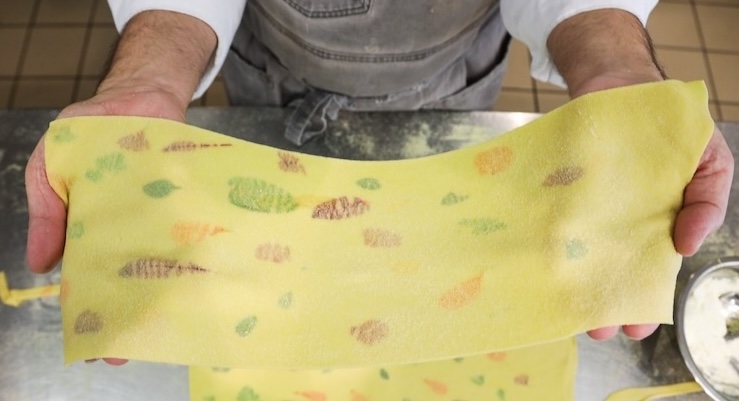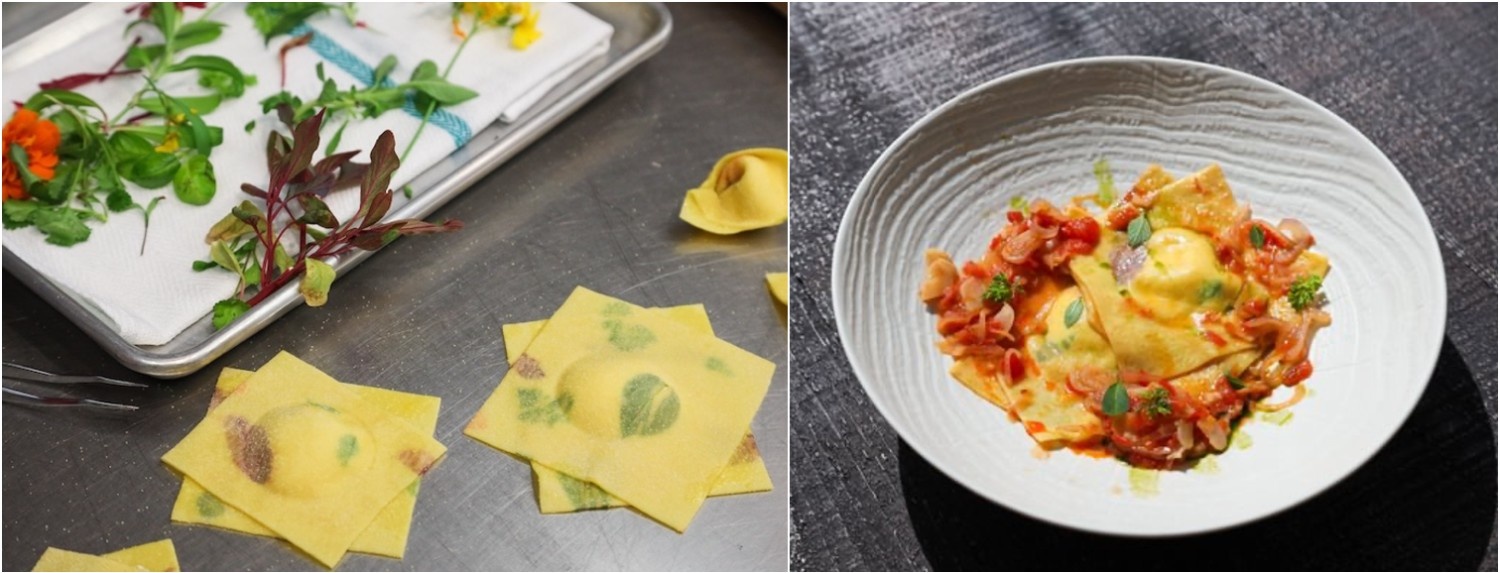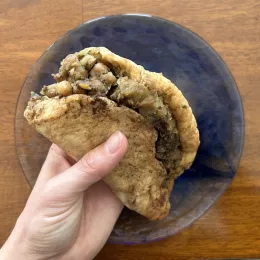With just one technique, a simple pasta can turn into a piece of abstract art, dancing with pops of color. The secret to creating these colorful doughs is lamination.
Though you might associate “laminated doughs” with croissants, Danishes, and puff pastry, culinary chefs can also use lamination to elevate pasta. When laminating pastry dough, a block of fat becomes encased inside the dough through folding and rolling, which results in delicate, flaky layers once baked.
Laminated pasta dough follows a similar method, and those luscious layers can be used to add some flair. When making laminated pasta dough, the chef can embed colorful herbs and flowers between two sheets of pasta, which are rolled together and then shaped.
The process is endlessly customizable and the result is pasta freckled with vibrant petals and colorful leaves. Director of Culinary Affairs Hervé Malivert loves to make laminated pasta dough, so read on for his expert tips.

Pasta Shapes and Sauces for Herb-Laminated Dough
Adding a botanical element to pasta dough through lamination adds another dimension to the plate — remember, we eat with our eyes first.
"Make sure to use the dough in applications where the patterns will be visible," Chef Hervé says.
He suggests using shapes like ravioli or pappardelle to showcase the colorful add-ins, as narrower noodles and stuffed shapes like fettuccine or tortellini won't show their colors well.
It’s also important to consider the sauce. While a wide noodle like lasagna may seem like the perfect canvas, once the noodle is stacked and buried under red sauce, the design disappears. When making laminated pastas, Chef Hervé likes to make a simple butter sauce with shallot, garlic, and a single tomato to let the dough shine.
Chef Hervé used pasta dough enriched with eggs to make the dough in these photos, but semolina dough can also be used with this technique.
Selecting Herbs & Flowers
ICE’s Hydroponic Garden grows over 80 different types of plants in water, so Chef Hervé has many options to choose from to decorate his laminated pastas. The garden has cherry tomatoes, yellow strawberries, micro greens, herbs and flowers. Plus, the farm's manager is always open to suggestions for new plants to grow. Students at the New York campus can visit the Hydroponic Garden at any time to taste and volunteer.
Related Read: How Caleb Raff Manages ICE’s Hydroponic Garden
“Adding botanical elements to pasta in this way only adds a subtle flavor, so it’s more for show than taste,” Chef Hervé says.
For this demonstration, he picked basil, chervil, and cilantro as herbs to add to the dough, specifically plucking younger, smaller leaves that are delicate. If using larger leaves, Chef Hervé suggests removing the main vein and stem as they can break through the pasta dough.
To balance all that greenery, Chef Hervé looked for a variety of colorful flowers and landed on wood sorrel, marigold, and dianthus. He used just the petals from the flowers, which add a floral aroma to the dough.
Adding the Botanical Elements
To make herb-laminated pasta, follow the standard process for making and kneading pasta dough. Roll it out until it is just thin enough for you to see through, then cut it in half so you have two sheets of the same size.
Chef Hervé likes to mist one sheet of the pasta with water so the toppings stick. Once the dough is moist, carefully arrange the herbs and flower petals on top of it. Add as much or as little botanical decoration as you’d like, but know that the leaves and petals will stretch out as the dough is passed through the roller again.
He then spritzed the sheet again with water to act as a glue and placed the second pasta sheet on top. Using a rolling pin, Chef Hervé smoothed the two sheets together, making sure to remove air bubbles.
And that’s it! Run the dough back through the roller on a lower setting now that the two pasta sheets are combined, and then shape as desired.

Although this process is pretty simple, Chef Hervé explains that it is often too time consuming for a restaurant to execute multiple portions at a time. The delicate work would be better suited to being a special dish where the restaurant might only need 15 portions or less.
“Being a chef is being a craftsman,” Chef Hervé says. “We have to have the skill and ability to execute culinary techniques. In this case, making the pasta dough is the craft. Elevating it with herbs and flowers to make it beautiful is the creative part. But don’t forget, a chef always has to make something the customer is going to like.”
Get the farm-to-classroom experience in ICE’s Plant-Based Culinary Arts program.







